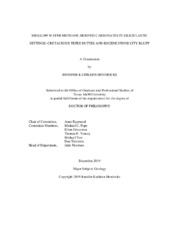| dc.description.abstract | Methane-derived carbonates occur in siliciclastic settings globally and precipitate from bicarbonate derived from methane oxidation. Methane-derived carbonates, which occur from the Archean to the present, take diverse forms, and have developed in a variety of depositional settings. This dissertation explores methane-derived carbonates from the Late Cretaceous Tepee Buttes (western US) and the Eocene Stone City Bluff (TX). The Tepee Buttes are large carbonate mounds in the Pierre Shale. This study of 28 separate mounds from six different locations in southern Colorado identified six carbonate lithofacies comprised of the same common components in different proportions. Lithofacies have gradational boundaries and are randomly distributed on the mound surface, rather than concentrically zoned around a large, central vent. Horizontal beds visible on some mounds lie haphazardly on top of lower beds, which suggests formation as planar beds beneath the sediment-water interface, rather than as tall, elevated mounds with steeply dipping sides: the present-day configuration of the Tepee Buttes results from weathering and erosion. Mounds near Florence, CO, on the western side of the study area have a unique, lithofacies characterized by early diagenetic, ironrich micrite.
Mound locations differed in degrees of matrix heterogeneity, but without a discernable pattern. Seep carbonate was formed from bacterial methane, likely sourced from the underlying Pierre Shale; there is no evidence for a change in the source of methane through time. A forebulge acted as a trap to accumulate migrating methane. The Stone City Bluff, TX, preserves barrel-shaped, vertically oriented septarian carbonate concretions associated with methane seeps. Barrel concretions preserve an internal micropipe, lined in pyrite, that preserves shell fragments and sedimentary features demonstrating fluid migration. The concretions have shrinkage cracks partly infilled with two generations of calcite. The δ13C values of barrel carbonates are associated with the oxidation of bacterial methane generated in shallow shelf sediments during the Middle Eocene Climate Optimum that was expelled by sediment compaction. The Tepee Buttes are the surface expression of a cold seep system; concretions from Stone City Bluffs preserve the subsurface plumbing. Together, these localities illustrate methane seeps from source, migration through the subsurface, to the surface expressions. | en |


